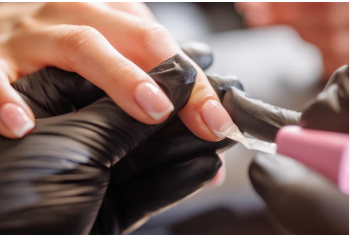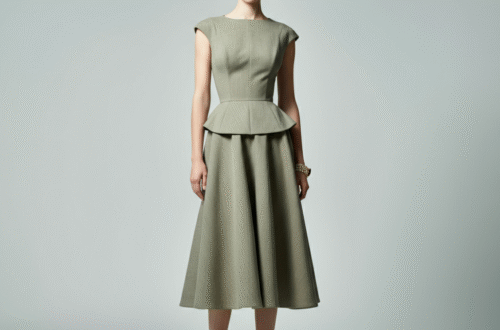Choosing the perfect manicure can feel like a big decision. Walk into any nail salon, and you’re met with a menu of options, with two of the most popular being acrylic and gel nails. Both promise long-lasting, beautiful results, but they are very different. The debate over acrylic vs gel nails is a common one, and understanding the key distinctions can help you pick the best option for your lifestyle, budget, and nail health.
This guide will break down everything you need to know. We’ll explore the application process, appearance, durability, cost, and removal for both types of manicures. By the end, you’ll be able to confidently decide whether you’re on team acrylic or team gel.
Key Takeaways
- Acrylic Nails: Made from a liquid monomer and powder polymer, acrylics create a hard, protective layer over the natural nail. They are known for their durability and are great for adding length.
- Gel Nails: Applied with a gel polish that is cured under a UV or LED lamp, gels are more flexible and have a glossier, more natural-looking finish.
- Durability: Acrylics are generally stronger and more resistant to breakage, making them ideal for heavy-handed individuals. Gels are more flexible but can be prone to chipping if not applied correctly.
- Application & Removal: The application for acrylics involves strong-smelling fumes, while gels are odorless. Removal for both should be done by a professional to avoid damaging the natural nail.
- Cost: The initial cost for both is often similar, but acrylics may require more frequent fills, potentially affecting the long-term cost.
What Are Acrylic Nails?
Acrylic nails have been a salon staple for decades. They are created by mixing a liquid monomer with a powder polymer. This combination forms a paste-like bead that the nail technician skillfully shapes onto your natural nail or a nail tip. The mixture hardens as it is exposed to the air, creating a strong and durable surface.
The Application Process
Getting a full set of acrylics starts with prepping your natural nails. A technician will file, buff, and clean your nails, often pushing back or trimming your cuticles. They might also apply a primer to help the acrylic adhere better. Then, the technician will dip a brush into the liquid monomer and then into the powder polymer, creating a small ball of acrylic. This is carefully applied to your nail and sculpted into the desired shape and length. This process is repeated for each nail. Because the acrylic hardens on its own, no special lamp is needed.
Who Are Acrylics Best For?
Acrylics are an excellent choice for people who want to add significant length and strength to their nails. If you have a habit of biting your nails, the hard shell of acrylic can help you break the habit. They are also incredibly durable, so if you work with your hands a lot or are prone to breaking your nails, acrylics can provide the reinforcement you need. They offer a great canvas for intricate nail art and can be shaped into various styles, from square to stiletto.
What Are Gel Nails?
Gel nails have surged in popularity for their glossy finish and natural feel. Unlike acrylics, gel nails come in a polish-like consistency. The process involves painting on a few thin coats of a specialized gel formula—typically a base coat, two or more color coats, and a top coat. Each layer is “cured,” or hardened, under a UV or LED lamp for 30 to 60 seconds.
The Application Process
Similar to an acrylic application, a gel manicure begins with nail preparation. Your nails are cleaned, filed, and buffed to ensure the gel adheres properly. The technician then applies a thin base coat and cures it under the lamp. Next, they apply the color coat (usually two layers, curing after each) and finish with a glossy top coat, which is also cured. The result is a smooth, shiny, and instantly dry manicure. The discussion of acrylic vs gel nails often highlights this quick, odor-free application as a major benefit for gels.
Who Are Gels Best For?
Gel nails are perfect for those who want a long-lasting manicure but prefer a more natural look and feel. They are more flexible than acrylics, so they feel less heavy on the nails. If you already have decent nail length and just want to add strength and color that won’t chip for weeks, gels are a fantastic option. They are also odorless, making the salon experience more pleasant for those sensitive to the strong chemical smell of acrylic monomer.
Comparing Acrylic vs Gel Nails Head-to-Head
When you’re trying to decide, a direct comparison can make things clearer. Let’s look at the key factors in the acrylic vs gel nails debate.
|
Feature |
Acrylic Nails |
Gel Nails |
|---|---|---|
|
Appearance |
Can appear thicker, matte or glossy finish available. |
High-gloss, shiny, and more natural-looking. |
|
Durability |
Very strong and durable, less prone to breaking. |
Flexible and less prone to chipping, but not as strong. |
|
Flexibility |
Rigid and inflexible. |
More flexible than acrylics, moves with the nail. |
|
Application |
Monomer and polymer mix, air-dries. Has a strong odor. |
Polish-like gel cured under a UV/LED lamp. Odorless. |
|
Removal |
Soaked in acetone, can be time-consuming. |
Soaked in acetone, generally faster to remove. |
|
Nail Health |
Can weaken natural nails if not applied/removed correctly. |
Gentler on natural nails, but improper removal can cause damage. |
|
Cost |
Generally similar to gels, fills needed every 2-3 weeks. |
Similar to acrylics, can be more expensive for complex designs. |
Durability and Maintenance: Which Lasts Longer?
Durability is a major factor when investing in a manicure. Both acrylic and gel nails are designed to outlast traditional polish.
Acrylic Nail Durability
Acrylics are the undisputed champion of strength. Their hard, rigid structure makes them highly resistant to breaks. With proper care, a set of acrylics can last for a long time. However, they do grow out with your natural nails, creating a gap near the cuticle. To maintain them, you’ll need to go back to the salon for a “fill” or “infill” every two to three weeks. During a fill, the technician files down the acrylic and fills in the growth area.
Gel Nail Durability
Gel nails are also durable, but in a different way. Their flexibility makes them less likely to snap under pressure compared to the rigidity of acrylics. A gel manicure can last for two to three weeks without chipping or peeling. However, they can sometimes lift at the edges if not applied perfectly. Unlike acrylics, you typically don’t get “fills” for gel polish. The entire manicure is soaked off and redone at each appointment.
Cost and Affordability
The price of a manicure can vary widely based on your location, the salon’s reputation, and the skill of your technician.
A full set of acrylic nails and a full set of gel nails are often priced similarly, typically ranging from $35 to $60 for a basic set. More complex designs, longer lengths, or special shapes will increase the cost.
For maintenance, acrylic fills usually cost less than a new full set, often around 50-70% of the original price. Since gel polish is removed and reapplied each time, you’ll pay the price of a full manicure at every visit. Over time, the costs can even out, depending on how often you visit the salon. It’s always a good idea to check out different styles and trends, like those on a fashion blog such as truefashionstory.com Blog, to see what looks you might want before you book an appointment.
The Removal Process: Protecting Your Natural Nails
How your manicure is removed is just as important as how it’s applied. Improper removal is the leading cause of nail damage for both acrylics and gels.
Removing Acrylic Nails
Removing acrylics involves soaking your nails in acetone for about 20-30 minutes. The acetone breaks down the acrylic, turning it soft and jelly-like. A technician will then gently scrape off the softened product. It is crucial not to pry or pull the acrylics off, as this will peel away layers of your natural nail and cause significant damage.
Removing Gel Nails
Gel nail removal is similar but usually faster. Your nails are wrapped in acetone-soaked cotton balls and foil. After about 10-15 minutes, the gel polish should lift and be easily scraped away. Just like with acrylics, you should never peel off your gel manicure. Even if it starts lifting, peeling it off will take layers of your nail with it, leaving them thin and weak. Professional removal is always the safest bet.
Final Verdict: Which One Should You Choose?
So, after exploring the world of acrylic vs gel nails, how do you choose? The best manicure for you truly depends on your personal needs and preferences.
- Choose Acrylics if: You want to add significant length, need maximum durability for an active lifestyle, or enjoy dramatic nail shapes like stiletto or coffin. They are also a great tool to help break a nail-biting habit.
- Choose Gels if: You prefer a natural-looking, glossy manicure, have some natural nail length, and want a long-lasting color without the heaviness of acrylics. The odorless application is also a big plus for many.
You can always switch between them. Trying both can help you discover which one works best for your nails and your daily life. A great manicure is a form of self-expression, so have fun with it and choose what makes you feel best.
Frequently Asked Questions (FAQ)
Q1: Which is better for your nails, acrylic or gel?
A: Both can cause damage if not applied or removed correctly. However, gel nails are generally considered slightly gentler on the natural nail because the removal process is quicker and the product is more flexible.
Q2: Can I get nail art with both acrylic and gel nails?
A: Absolutely! Both acrylics and gels provide a great base for all kinds of nail art, from simple glitter to complex, hand-painted designs.
Q3: How often do I need to get my nails done?
A: For acrylics, you’ll need a fill every 2-3 weeks to cover nail growth. For gels, you’ll need a full removal and reapplication every 2-3 weeks, depending on how fast your nails grow and how well you care for them.
Q4: Is the UV light for gel nails safe?
A: The exposure to UV light during a gel manicure is very low, and most studies suggest the risk is minimal. If you are concerned, you can apply sunscreen to your hands before your appointment or wear UV-protective gloves. Many salons now use LED lamps, which cure the gel even faster and use a different light spectrum.





